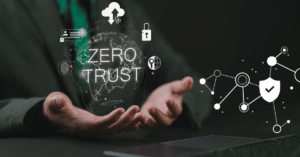Cybersecurity Awareness Month 2025: Key Trends in IoT Security

October marks Cybersecurity Awareness Month 2025, with this year’s theme “Building a Cyber Strong America” emphasizing the critical need to strengthen infrastructure against evolving cyber threats. As organizations across healthcare, manufacturing, energy, and other critical infrastructure navigate an increasingly connected landscape, Internet of Things (IoT) security has emerged as a cornerstone of this national effort.
The numbers paint a stark picture. With more than 27 billion IoT devices now in use globally, the attack surface has expanded exponentially. More than 50% of these devices contain critical vulnerabilities that attackers can exploit right now. Perhaps most concerning, one in three data breaches now involves an IoT device—a statistic that underscores why IoT security can no longer be treated as an afterthought.
The Evolving Connected Device Threat Landscape
The IoT threat landscape has intensified dramatically over the past year. IoT devices face approximately 820,000 attacks daily, with threat actors increasingly targeting operational technology (OT) environments. Ransomware attacks against OT systems have surged by 46%, demonstrating that attackers recognize the critical nature of these environments and the potential for maximum disruption.
For healthcare organizations managing Internet of Medical Things (IoMT) devices, the stakes are even higher. The average cost of an IoMT breach now exceeds $10 million, reflecting not just financial impact but the potential disruption to patient care and safety.
Combined, these statistics paint a picture that information security leaders can’t ignore: IoT, OT, and IoMT need to be a top consideration in a comprehensive cybersecurity strategy.
Key Trends Shaping IoT Security in 2025
The Rise of AI-Powered Risk Prioritization
Organizations are turning to artificial intelligence and machine learning to combat the overwhelming volume of vulnerabilities. Traditional approaches that rely solely on Common Vulnerability Scoring System (CVSS) scores fail to provide the context needed for effective prioritization. Modern IoT security platforms now leverage AI to analyze exploitability in real-world conditions, considering factors like network architecture, device configurations, and active threat intelligence.
This shift from objective severity scores to contextual risk assessment represents a fundamental change in how organizations approach vulnerability management. A vulnerability with a CVSS score of 10 on an isolated device poses vastly different risks than the same vulnerability on a device tightly woven into critical infrastructure.
Regulatory Pressures Push for Improved Visibility in OT
In August 2025, CISA joined forces with eight international agencies—including the NSA, FBI, EPA, and cybersecurity centers from Australia, Canada, Germany, the Netherlands, and New Zealand—to declare OT asset inventory a foundational Cybersecurity Performance Goal, marking a pivotal shift in how critical infrastructure organizations must approach security. This unprecedented multi-agency collaboration underscores a sobering reality: organizations without comprehensive asset inventories fundamentally don’t know what they have and what should be secured, leaving them vulnerable to cyber actors targeting energy, water, manufacturing, and other essential services. What makes this trend particularly significant for Cybersecurity Awareness Month is the recognition that asset visibility isn’t just a technical checkbox—it’s the enabling foundation for every other security control, from vulnerability management and network segmentation to incident response and risk prioritization. As organizations face mounting pressure to comply with CISA CPGs while managing increasingly complex OT environments with legacy systems and proprietary protocols, the message is clear: you can’t defend what you can’t see, and manual inventory processes can no longer keep pace with the speed and sophistication of modern threats.
Enhanced Visibility Through Deep Packet Inspection
Comprehensive visibility remains the foundation of effective IoT security. Organizations are moving beyond basic asset inventories to implement deep packet inspection (DPI) combined with AI/ML techniques. This approach provides accurate, real-time insights into device behavior, configurations, and potential anomalies, removing the errors associated with manually interpreting raw inventory data.
Healthcare systems, in particular, have found that comprehensive visibility enables them to maintain compliance while keeping mission-critical devices operational. Understanding every device on the network, its vulnerabilities, and its potential attack paths has become non-negotiable.
Focus on Exploitability Over Volume
With more than 20,000 new vulnerabilities identified each year, security teams face an impossible task if they attempt to patch everything. The modern approach emphasizes exploitability—determining how likely an attacker is to successfully breach systems based on specific weaknesses in your unique environment.
This means analyzing multiple data sources, including Software Bills of Materials (SBOMs), Manufacturer Disclosure Statements for Medical Device Security (MDS2s), the MITRE ATT&CK framework, and threat intelligence feeds. Organizations that focus on truly exploitable vulnerabilities can reduce remediation time by up to 90%, allowing security teams to concentrate on genuine threats rather than theoretical risks.
Integration and Automation as Force Multipliers
Modern cybersecurity tools can’t operate in isolation. Integration capabilities that connect IT, IoT, OT, and IoMT are necessary to provide a comprehensive risk mitigation strategy for organizations. Existing security tools—from network access control (NAC) systems to Security Information and Event Management (SIEM) platforms—enable automated workflows and efficient remediation, but without a comprehensive IoT Security Solution, these tools contain siloed information that teams need to reduce risk. Improving the integrations between these tools through comprehensive technology reduces the manual effort required to neutralize threats, allowing security teams to work smarter, not harder, in 2026.
Building a Cyber Strong Future
As Cybersecurity Awareness Month 2025 emphasizes building national resilience, organizations must recognize that IoT security is no longer just an IT issue—it’s a public safety and economic security priority. The convergence of IoT, OT, and IT demands a unified approach to visibility, risk assessment, and mitigation.
Success requires moving beyond traditional vulnerability management approaches. Organizations need platforms that provide comprehensive visibility across all connected devices, leverage AI to prioritize based on real exploitability, automate remediation workflows, and integrate seamlessly with existing security infrastructure.
The challenge is significant, but the tools and strategies now exist to address it effectively. By focusing on contextual risk rather than raw vulnerability counts, organizations can reduce their attack surface while maintaining the operational continuity that modern connected infrastructure demands.
This Cybersecurity Awareness Month, the message is clear: securing IoT devices isn’t just about protecting individual assets—it’s about strengthening the critical infrastructure that our economy, healthcare systems, and society depend on. Organizations that embrace comprehensive IoT security strategies today are building the cyber-strong foundation needed for tomorrow’s challenges.
Secure Every IoT Device.
Automatically.
Cyber threats move fast — so should you. Asimily gives instant inventory and smart, prioritized risk mitigation insights for every IoT, OT, and IoMT device — so you can take action before threats strike.




